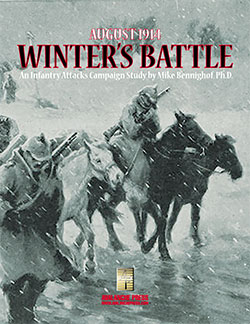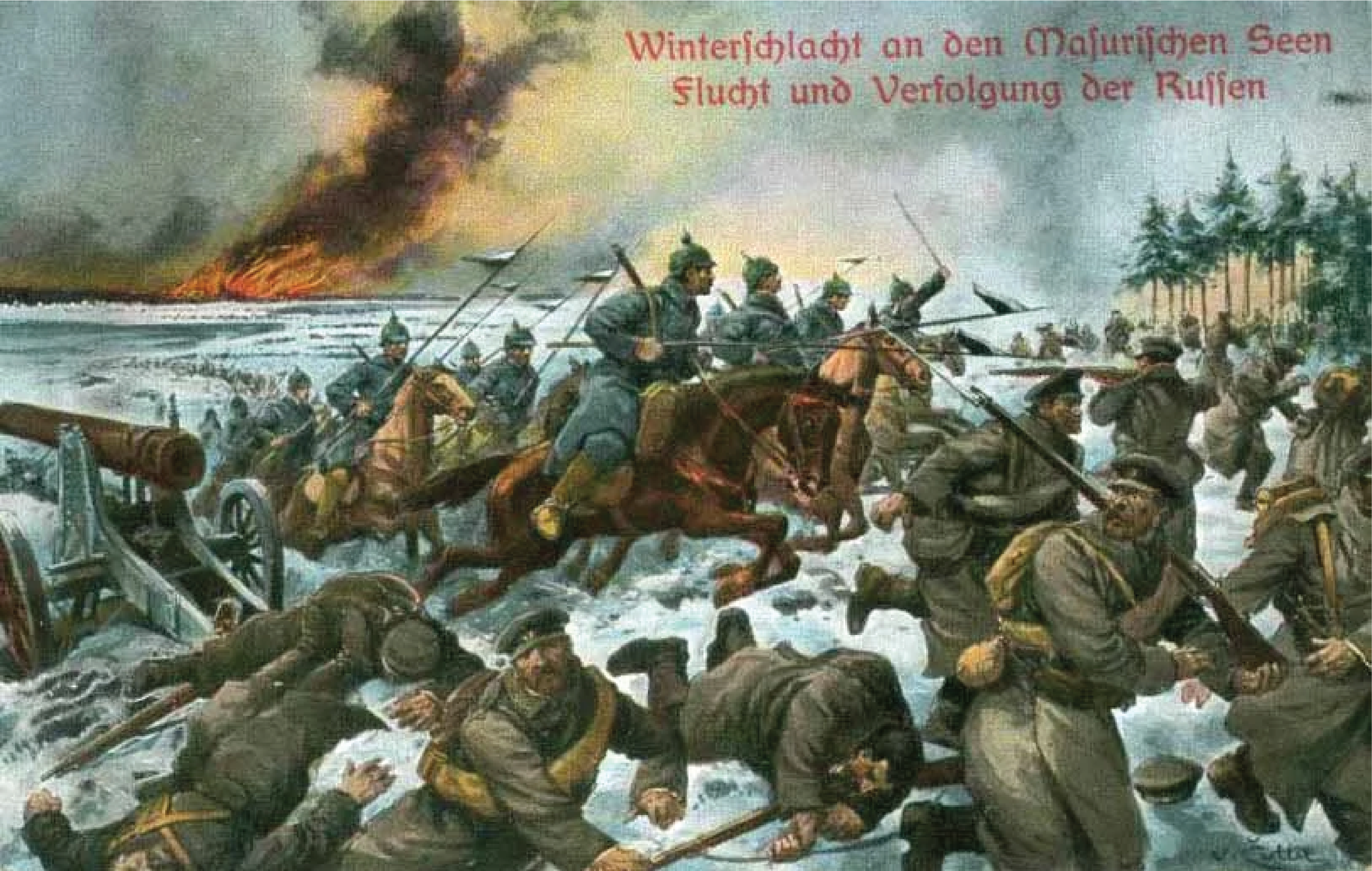| Winter’s Battle:
Publisher’s Preview
By Mike Bennighof, Ph.D.
September 2022
 The Winter Battle of Masuria, as it’s called in German-language histories, jumped off on 7 February 1915 and lasted for 15 days. The German high command – in this case, Paul von Hindenburg, newly promoted to field marshal and anointed as commander-in-chief of the German forces on the Eastern Front, and his chief of staff, Erich Ludendorff – intended the Second Battle of the Masurian Lakes to be a war-winning effort. It would not be the last such effort to fail to live up to expectations. The Winter Battle of Masuria, as it’s called in German-language histories, jumped off on 7 February 1915 and lasted for 15 days. The German high command – in this case, Paul von Hindenburg, newly promoted to field marshal and anointed as commander-in-chief of the German forces on the Eastern Front, and his chief of staff, Erich Ludendorff – intended the Second Battle of the Masurian Lakes to be a war-winning effort. It would not be the last such effort to fail to live up to expectations.
That wasn’t due to lack of success; the German attack by the Eighth and Tenth Armies crushed the opposing Russian Tenth Army, inflicting upwards of 150,000 casualties (over half of them prisoners) at the cost of up to 32,000 Germans killed, wounded and captured. But it failed to meet the hopes of Hindenburg and Ludendorff to encircle and destroy the Russian Tenth Army in a repeat of the August 1914 Battle of Tannenberg. Given the heavy snow on the ground and the blinding blizzards, that was never going to happen.
But it is a fascinating battle, waged amid howling blizzards on snowy, trackless battlefields. The Germans performed extremely well; the Russians, not so much, but when they had to make a stand to stop the Germans and save Tenth Army, XX Corps held its ground. Its two divisions would be destroyed, but they delayed the Germans long enough for the rest of the army to escape.
That’s the theme of our Infantry Attacks Campaign Study, Winter’s Battle. It’s just a small book, telling the story of the battle and letting you play out the action in 10 new scenarios. You’ll need August 1914 for the maps and most of the pieces; you’ll also need Fall of Empires for Russian Reservist infantry companies (which we didn’t include in August 1914, because they were once intended to form one huge combined game).

Those 10 scenarios are split into two chapters: one based on the offensive of the German Eighth Army, and one based on the offensive of the German Tenth Army. Each chapter winds up with a battle game that ties the scenarios together, something we’ve been doing for the past few years in our tactical game series (Panzer Grenadier, Panzer Grenadier (Modern) and Infantry Attacks). The blend of history and game play tells the story of the battle (in this case, that of the Second Masurian Lakes) with the scenarios as part of the narrative. It’s a unique approach, and it gives you a rich experience that you can’t get from just reading a book about the battle or playing an old-style wargame.
The German forces here are built around the reserve corps shifted eastwards after the Battle of Ypres, including the student volunteers supposedly slaughtered while singing Deutschland Über Alles (spoiler: that’s not what really happened). By this point in the war the “Reserve” formations have been hardened by combat and while still lacking the same core of long-service professionals they’re certainly capable combat units. The Landwehr divisions that performed surprisingly well during the last summer and autumn campaigns now finally dropped back into second-line duties for the most part; the old guys outdid themselves but couldn’t keep it up forever.
 The Russians had also brought up additional forces since the battles of August 1914, including their tough Siberian regiments. But their order of battle also included a great many Reserve divisions, which didn’t come as close to matching the performance of the regulars as did their German counterparts. The Russians had also brought up additional forces since the battles of August 1914, including their tough Siberian regiments. But their order of battle also included a great many Reserve divisions, which didn’t come as close to matching the performance of the regulars as did their German counterparts.
The scenarios themselves play quite differently than those of August 1914 (the game). These are no longer the virgins with rifles stumbling forward, often heedless of their losses. The German Army has learned, the hard way, the value of artillery preparation even if the quantity of guns and shells has not yet caught up to the needs of the front-line forces. Both sides have seen a drop in the number of eager young officers ready to stand in the line of fire, draw their swords and shout, “Follow Me!” Meanwhile, the rank-and-file, particularly on the Russian side, has seen its trained cadre diminished and simple skills like entrenching have deteriorated.
And then there’s the weather. The battlefield is covered in snow drifts, and the temperature has fallen to brutal, deadly cold: -15 Celsius, or 5 degrees Fahrenheit. Yet the cold hasn’t been in effect long enough to freeze the swampy ground in many areas. It’s a highly unpleasant battlefield, with movement limited to the roads in places, roads covered in snow drifts two meters deep.
 In both chapters, the burden of the attack is on the Germans. The Russians are ill-prepared to face a winter assault, but they do have the advantage that movement, coordination and even artillery fire are very difficult for the Germans. They also are tied to the roads to make much progress against the snow, but they’ll have to move off of them eventually to get at the Russians. In both chapters, the burden of the attack is on the Germans. The Russians are ill-prepared to face a winter assault, but they do have the advantage that movement, coordination and even artillery fire are very difficult for the Germans. They also are tied to the roads to make much progress against the snow, but they’ll have to move off of them eventually to get at the Russians.
The Campaign Study format allows us to concentrate on just one battle or campaign and give it an intense treatment, with both background notes and the scenarios themselves. Infantry Attacks: Winter’s Battle is just a small book, but it adds another dimension to August 1914 and keeps the game fresh, with a set of scenarios that wouldn’t have fit with that game’s theme. I don’t want to ever go back to the shotgun approach, of tossing a bunch of random scenarios into the box that cover all manner of battles from unrelated times and places across the front lines or possibly even years.
Winter’s Battle is the sort of book that I want to write, and that I want to publish. It’s a tightly-focused look at just one battle, with scenarios showing how the action played out on the battlefield – where you, the player, get to make the decisions and see how it could have turned out differently. Lots of wargame advertising makes that claim, and has since the 1960’s. This format lets us actually do that, to meld history and game-play into one experience.
The book’s intended for those who play these games for the history. That’s not everyone, but for those who do, you’re going to like it.
You can order Winter’s Battle right here.
Infantry Attacks Package
August 1914
Fall of Empires
Franz Josef’s Armies
Winter’s Battle
Retail Price: $212.96
Package Price: $170
Gold Club Price: $136
You can experience the Infantry Attacks Package right here.
Sign up for our newsletter right here. Your info will never be sold or transferred; we'll just use it to update you on new games and new offers.
Mike Bennighof is president of Avalanche Press and holds a doctorate in history from Emory University. A Fulbright Scholar and NASA Journalist in Space finalist, he has published a great many books, games and articles on historical subjects; people are saying that some of them are actually good.
He lives in Birmingham, Alabama with his wife and three children. He misses his Iron Dog, Leopold.
Want to keep Daily Content free of third-party ads? You can send us some love (and cash) through this link right here.
|
